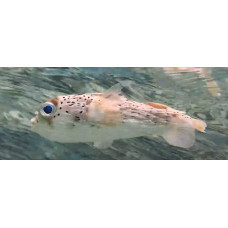Latin name
Diodon holocanthus
Other names
Reckled porcupinefish, porcupine puffer, porcupine pufferfish.
Identification
They have an elongated, rounded body with smooth skin covered with long, sharp spines that are modified scales. Each spine has two roots. All spines are mobile and can be raised 90°. When the fish is at rest, the spines are pressed against the body. The head is spherical with large eyes. The width of the head is 2.4-3.3 times the standard body length. The gill openings are small and located at the base of the pectoral fins.
Teeth
The mouth is large and wide, terminal and almost always open. The teeth are fused into plates. The incisors on the upper and lower jaws are continuous, i.e. not separated by a suture. Therefore, the mouth with jaws and incisors resembles a parrot's beak.
Features of fish fins
The dorsal and anal fins are shifted to the caudal peduncle and have no barb rays. The dorsal fin has 13-15 soft rays and the anal fin has 13-15 soft rays. The pectoral fins have 21-24 soft rays. In adults, these fins, as well as the caudal fin, have rounded edges. The pelvic fins are absent.
Fish colouring
Larvae are yellow with red spots scattered over the body. In the juvenile stage, the yellow and red coloration disappears and the olive and brown coloration characteristic of adults appears. Dark spots appear on the flanks, which serve as camouflage against predators.
Distribution
Widespread in tropical and subtropical waters of all oceans. Indian Ocean: from southern Africa to the Red Sea, Sri Lanka, India and all major island groups. Absent from the Persian Gulf. Western Pacific: from southern Japan to Australia, including the Hawaiian Islands, New Caledonia, and the Lord Howe Islands. Eastern Pacific: from Southern California to Peru, including the Gulf of California and the Galapagos Islands. Western Atlantic: from southern Canada and New Jersey along the U.S. coast to Bermuda and the Bahamas, the Gulf of Mexico, the Caribbean Sea, and further south along the coast of South America to Brazil. Eastern Atlantic: Along the coast of Africa from Sierra Leone to Angola, off Ascension and St. Helena Islands.
Habitat
Subtropical marine species. Depth ranges from 2 to 200 m, usually 2 to 35 m. Juveniles lead a pelagic lifestyle, sheltering in floating sargassum algae. After reaching a length of 6-9 cm, juveniles move closer to shore and adopt a benthic lifestyle.
Size
Long-spined porcupinefish reach a maximum body length of 50 centimeters, usually around 15 centimeters.
Behavior
When threatened, these fish can fill their distended stomachs with water, inflating their entire bodies into a spherical shape and raising their spines.
They inhabit shallow reefs and open areas with soft bottoms. Also found in areas with rocky bottoms. Solitary, but sometimes in groups. Found in open muddy areas and on rich soft bottoms and coral reefs. Juveniles often swim on rafts of sargassum.
Food and feeding habits
Feeds on molluscs, sea urchins, hermit crabs and crabs at night. Relatively poor swimmers.
Reproduction
Spawn near the surface in open water. Just before spawning, the male slowly pushes the female to the surface. Fertilization is external. Eggs are spherical, 1.7-1.8 mm in diameter with 10-30 yellowish fat droplets, pelagic. The larvae emerge after about four days. By this time they are well developed, with a functioning mouth, eyes, and swim bladder. For up to ten days, the larvae are covered with a thin shell, which then falls off and spines begin to develop. Metamorphosis is complete three weeks after hatching. All fins and their rays have already appeared, teeth are formed.
Fishing
Removed from the surface by netting. No particular commercial value to fishermen.
Relationship with a person
The skin and guts of the long-spined porcupinefish are toxic due to the accumulation of tetrodotoxin. There have been reports of ciguatera poisoning. Used in Chinese medicine.
| Classification | |
| Phylum | Chordata |
| Class | Actinopterygii |
| Squad | Tetraodontiformes |
| Family | Diodontidae |
| Genus | Diodon |
| Species | D. holocanthus |
| Features | |
| Conservation status | Least Concern |
| Habitat | Pelagic |
| Life span, years | No information |
| Maximum body weight, kg | No information |
| Maximum length, cm | 50 |
| Sailing speed, m/s | No information |
| Threat to people | Not edible |
| Way of eating | Planktonophage |
Long-spine porcupinefish
Tags: long spine porcupinefish




